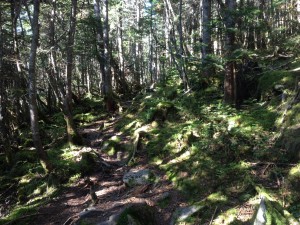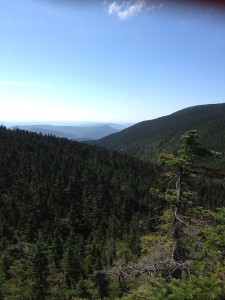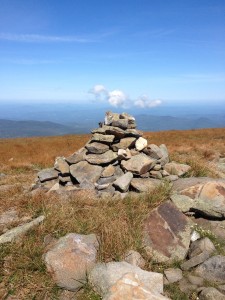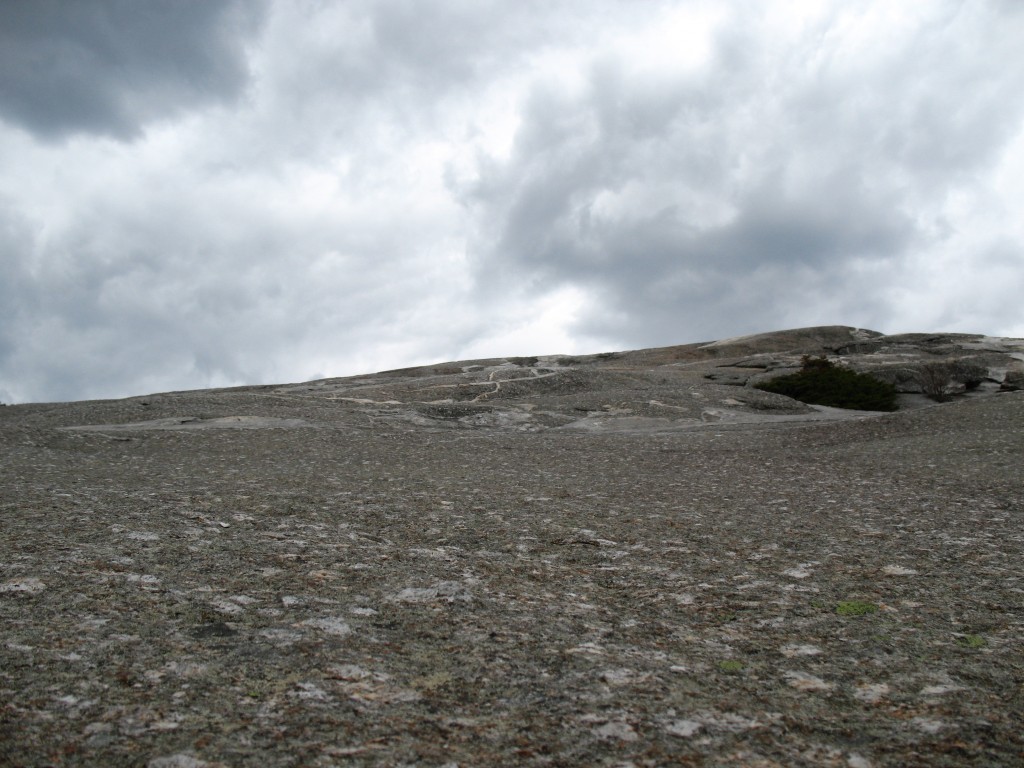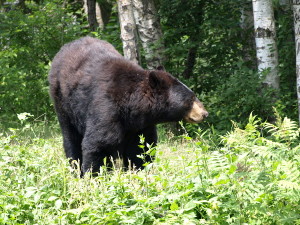Thoreau’s Journal, September 8th, 1846:
Hard bread—& pork getting short—go up—Mount
Cranberries and blue berries clouds—wind—-rain rocks
September 5th, 2015: A day on Moosilauke.
Cool morning trail, slanting sun, temperature about 50 – Asquam Ridge Trail
I begin along the Baker River, which flows out from Jobildunc Ravine, for an early mile; then, the trail slants away above itself, above the river, whose sound fades as if the dry end of summer has toweled up its last flow. And I am climbing across the slope’s grain, rising easily toward the next angled switch; and so I trace giant Zs into the ridge until I reach its crest, where the trees are smaller and the moss lies thick on the old stones. In one rare mud patch, the gouge of a moose-print, the grains of dirt still moist and fine, the moose just there, no longer here.
Jim is one of those mountains that isn’t. At least that’s true for “listers,” those who like to measure accomplishments one after the other. To make NH’s official 4000-footer list, a mountain must rise 200 or more feet from the col that links it to a higher, neighboring peak. Jim, despite a sizable drop on its west ridge, which joins it to the mass of Moosilauke, falls just short. And so Jim gets overlooked, but he is a fine mountain…or nice bump on the ridge…with a short boreal forest thick with moss and pronounced sense of summit.
From Jim I go to Blue, which truly is a ridgy knuckle and not a faux-peak. Though Blue too has its merits, chief of which is an outlook into the seldom traveled, marbles-in-mouth Jobildunc Ravine; there the Baker River wells from the ground before heading for its union with the Pemigewasset miles to the south.
The approach to Blue also brings me to the Appalachian Trail, or AT, and its iconic white paint blazes; whenever I step onto the AT, I feel the slight buzz of its long strand of connection. Some 1800 miles to the south is Springer Mountain; 300+ to the north is Henry Thoreau’s and Percival Baxter’s Ktaadn. The trail, called the Beaver Brook in this section, is battered as famous ways often are. Where the path on Jim was needle- and moss-softened, the Beaver Brook is hardened dirt and scuffed or pole-scarred stone. For a quarter-mile, where the trail skirts the upper edge of the ravine, it is slow going over great chunks of angled stone, the legos of the recent glacier. Then it is simply a foot-trench up a mild slope to the ice-worn roundness of Moosilauke itself.
Today, the unpeopled Asquam Ridge gives way to the little town that is Moosilauke. It is a warm, late summer day, and it is also first-year orientation for the college that owns this mountain; the top is busy with those who would stretch summer and those who have reached the first moments of this memorable four-year prominence. Dartmouth, for all the feet it brings to Moosilauke, has been a good steward, removing – over time – the shelters that once dotted the summit, lining the trails with scree walls to contain walkers, and providing clear signage to direct the many who would be disoriented. The sedgy grasses grow right up to the scree walls, as do the mountains cranberries in red profusion, and the crowds confine themselves largely to the summit rocks and foundation remnants from the old Victorian summit hotel.
I reach the summit and then walk back north, counting as always cairns. If I ignore the superfluous first cairn right next to the top, it’s five cairns to visit my dad. Eight years ago, we scattered his ashes at this cairn; now whenever I visit, I seat myself on a flat rock facing west, lean back against its cone and talk quietly about whatever life-thoughts I’ve carried up here with me. Today, it’s a usual – the years I’ve walked through and my hope to keep walking toward his 80th and 85th birthdays, both of which we celebrated on this summit. After an irksome, summer run of minor leg injuries, I’ve reached his cairn in 2 1/2 hours, and my legs feel live. “It’s all good,” I murmur, repeating his last words.
The day pivots on this meditative half hour at the cairn; rising to walk again, I breeze by the jumble of rocks and people at the top and on along the old Carriage Road, across a mile of ridge to the South Peak, which is usually less peopled, though today it holds a group of eight 30-somethings, led – it soon becomes apparent – by a linear-talking, earnest hiker who likes the word “scheduled.” They natter on about work; two of them flirt exclusively; their leader gestures at far peaks in a proprietary way. As they rise to leave, a falcon appears, riding a thermal, climbing quickly. I watch the bird, and a few of the group stop and wonder aloud about it. “A falcon, I think,” I say. “They nest over to the west in Oliverian Notch.” Their leader’s “not sure.” And then they leave and quiet washes over this minor summit like a topping tide.
What’s left after lunch on South Peak? The day’s descent, which for the first mile+ faces right into the southern sun. In a word, it’s hot. I opt for gravity-assisted quick-stepping and soon reach the shaded slanting traverse that comes finally to the river down. I reach my car some 5 hours after I set off, noting with a little satisfaction that a lithe twenty-something who set off just before me, and whom I’ve seen cantering along ridges a few times, has just gotten back too. I look back up to the broad ridge where a line of cairns show the way to which I will return.
Post-note: The finest mountain sauntering blog I know is Steve Smith’s – it’s called Mountain Wandering, named after his bookstore, The Mountain Wanderer, in Lincoln NH. Lots of fine photos; quiet, precise writing. Here’s its address:http://mountainwandering.blogspot.com/

